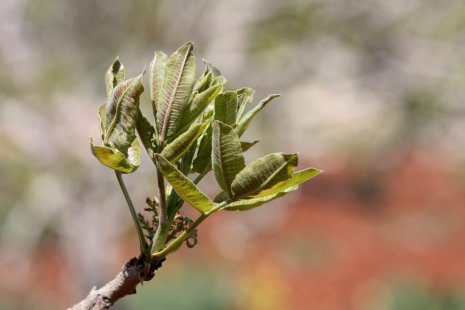
Be the doctor of your farm by knowing the disease of pistachio trees
One of the most important pistachio diseases is Pistachio Gommosis disease. Symptoms of the disease on the aerial parts of the pistachio tree unfortunately appear when the disease has covered the crown and trunk of the tree and in fact the tree has progressed to the point of death.
1- Gommosis disease of pistachios trees
One of the most important pistachio diseases is Pistachio Gommosis disease
Symptoms of the disease on the aerial parts of the pistachio tree unfortunately appear when the disease has covered the crown and trunk of the tree and in fact the tree has progressed to the point of death.
Clear and small gum bubbles are secreted on the main branches and aerial parts of the trunk, and the small branches start to wither from the end and suddenly a part or the whole tree dies.
In hot weather, due to the progress of the bark disease, the trunk of the tree becomes ring-shaped, and if the soil moisture reaches enough, wilting symptoms appear on the leaves
The first signs of contamination of the underground parts of the tree appear in the form of distinct soft spots on the surface of the bark of the crown and the part of the trunk that has gone under the soil.
These spots are mostly dark and sometimes brown or black, and because the bark of the tree is gray, the spots are clearly visible.
If we scratch the infected area with a knife, we will see a discolored texture. This affected tissue is superficial at first, but gradually expands and becomes deep until it covers the cambium area and all skin tissue.
A type of gum is secreted in the skin area, which is related to the advanced state of the disease; And that is why the disease is called Gommosis.
Symptoms of the disease appear at least after a period of three years on old Iranian Pistachio trees that are planted deeply and watered excessively.
Pistachio Gommosis rot is caused by Phytophtera species.
Fungus is the cause of Gommosis disease of the pistachio tree, which is a parasite that is active in the soil, and the most important factor that is involved in its growth and development is soil moisture.
Mushrooms grow a lot in moist soil environment and especially in heavy soils with high water holding capacity. The spread of the disease from one place to another and from one tree to another is done by zoospores, and the presence of high humidity in the ground is also an important factor for the movement of zoospores.
After humidity, soil temperature is also effective in the activity of fungi. In this way, mushroom growth is very low at temperatures below 8 degrees Celsius; And as the temperature increases, its growth increases and if other conditions are favorable, at 32 degrees Celsius, the mushroom will grow best and fastest.
If the temperature is 20 degrees Celsius, half of the above growth rate is possible.
If the temperature of the soil or the bark of the infected tree is higher than 32 degrees Celsius. Mushroom growth is slow and at temperatures higher than 36°C, mushroom growth almost stops
At a temperature of 40 degrees, the fungus dies within a few hours and at a temperature of 46 degrees within a minute. This is the reason why mushroom growth decreases in hot summer weather, and if we remove the soil from the base of the diseased tree in hot weather, so that the infected part is exposed to high heat, the mushroom growth decreases and may even be destroyed.
Soil acidity is also effective in mushroom activity. In soils whose pH value is between 5.4 and 7.5, the attack and growth of the fungus takes place in the most intense way, and on the contrary, in the acidity of 4.8 to 5, the intensity of the attack decreases.
Considering that the pH of the soil in most pistachio farming areas of Iran is more than 7 and it is difficult to change the pH on the acidic side, so it is practically impossible to fight the disease by interfering with this factor.
Deep planting and wrong watering of pistachio trees is important in causing and spreading the disease. For some insects, the carrier of the disease is mostly related to age
2- Nematode disease of pistachio tree
After Gommosis disease, it can be said that the most important pistachio disease is related to tuber producing nematodes. There are many reports of the existence of this nematode in the country's gardens and the damage caused by it.
The specific symptoms of this disease include the production of knots and glands on the roots and in the aerial parts, including the general weakness and low growth of the tree.
This disease is very dangerous when it enters the treasury, and in some cases it causes the death of the entire seedlings of the treasury.
According to the specific biology and epidemiology of the disease agent, it can be said that the best way to fight and deal with it is to use nematode-resistant pistachio trees, use healthy seedlings, and observe health principles, such as preventing the entry of the disease-carrying agent into the garden or treasury.
Although the use of nematicide chemicals is also effective, it is necessary to remember that in addition to the high costs of nematicide use, it also results in environmental pollution.
So far, among the studied bases, Vera species has been introduced as the most sensitive and the most resistant to tuber nematodes.
3- Root rot disease of pistachio trees.
The disease or complication of root rot is one of the most important diseases in pistachio farming areas, especially in jumbo and round varieties.
The complication gradually causes canker and necrosis or blackening in the trunk of the main and secondary branches.
This complication is mostly caused when the trees are not in proper nutrition and irrigation condition and as a result they do not have thick and proper foliage.
In this case, the skin of the branches are exposed to direct sunlight, and in this condition, the skin turns red and finally turns black with the attack of fungi.
One of the important ways to prevent and to a large extent cure the disease is the use of fungicides. Copper fungicides have shown good results in this.
For several years, oxychloromes has been sprayed in pistachio orchards after pruning the damaged branches with a concentration of 1.5 parts per thousand. Another combination of copper is Bardo's combination.
Using a combination of Bordeaux mixture
Bordeaux mixture is one of the best copper fungicides and bactericides with a protective effect.
Bordo mix is one of the healthiest mineral poisons. Due to its high adhesive properties, Bordo's composition is more resistant to rain washing. Bordo mix is safe for bees and repels snails and insects such as wasps and termites.
In American pistachio orchards, Bordo is widely used to fight fungal diseases and repel rodents because of its white color.
Bordo compound is obtained by mixing copper sulfate solution and calcium hydroxide. Bordo is a blue, non-crystallized, gelatinous substance with fine grains.
After being sprayed on the plant due to humidity and carbon dioxide, the Bordo mix gradually turns into complex compounds that constantly release soluble copper ions, the copper ions pass through the walls of fungal and bacterial cells and after being absorbed, the activity stops.
4- Pistachio Stigmatomycosis disease
Among other pistachio diseases, we can refer to pistachio Stigmatomycosis disease, this disease is prevalent in most of the pistachio farming areas of the country, especially Kerman, Rafsanjan, Fars, Qazvin and Damghan. The disease damages the pistachio fruit and the kernel of the affected fruit does not grow.
The percentage of contamination of pistachio fruits sometimes reaches more than 50%. This disease is also common in wild pistachios.
Disease symptoms:
Due to the attack of the disease, the pistachio fruits are apparently healthy, but the pistachio does not have a kernel, or the kernel grows a little and turns brown.
The kernel may be deformed and dry, and necrotic spots may appear on it.
Sometimes, the fruit looks healthy, but in infected unripe fruits, a viscous and colorless whitish substance is observed between the skin and the seed and the edges of the core. At the stage when the fruit is fully developed, this substance is white and relatively hard, and due to the presence of this viscous substance, it is white, which is why the disease is called Stigmatomycosis.
This fungus can spend the winter in infected pistachios that fall under the tree or inside the trunk of pistachio trees.
The occurrence of this disease on pistachio trees is directly related to the presence of some insects that carry the disease, which is mostly related to age
Fighting with pistachio Stigmatomycosis disease
Due to the fact that pistachio Stigmatomycosis disease is caused by the activity of the vector. It seems that the fight against these insects is effective in preventing the disease
Diseases are reduced in gardens where attention has been paid to trees such as watering and feeding and pest control. Climatic factors also have a significant effect on the severity and weakness of the disease.
5- Pistachio surface powdery mildew disease
The fungus (Phyllactinia pistaciae ) that causes this disease causes damage to many species of productive and non-productive trees. This disease attacks pistachio trees in areas such as Qazvin, Isfahan, Zarand, Kerman, Shiraz, Rafsanjan and Khorasan.
Symptoms :
It is a fungus called Phyllactinia gutta whose mycelium grows on the lower surface of the leaf and sometimes penetrates deep into the leaf and advances in the middle parenchyma and some mycelium is also superficial and constantly produces spots on the lower surface of the leaf.
Fighting pistachio powdery mildew disease :
Due to the fact that the disease starts to work mostly in the middle of summer, so its damage is not so great, and if the powdery mildew is severe in some areas, You can spray the trees with poison sprayer or sulfur poisons as soon as you see the first symptoms of powdery mildew on the back of the leaves.
6- Pistachio leaf spot disease
Pistachio leaf spot disease is observed in some pistachio farming areas of Kerman province. Symptoms of the disease can be seen as dark brown and black spots on the leaf and leaf tail, as well as the axis of the cluster and the green shell of the pistachio fruit.
In the beginning, these marks on the leaves are seen as small spots with a diameter of 1-3 mm, light brown in color, and gradually the spots become larger and their color becomes darker.
Contamination of spike tails and leaf tails also appears in a scattered and black color, which after some time causes drying of the fruit tail and cluster axis, after which the fruits begin to fall after drying.
On the green skin of pistachio fruits, the spots first appear in light brown color, which gradually darkens, and the green skin of the fruit takes on a cork-like appearance in the place of contamination and cracks in the place of the spot.
This disease is not very common and severe at present.
Pruning the branches adjacent to the ground and removing weeds and watering at the rate of 3 per thousand is recommended.
As the largest dried fruit and nuts supplier , Tahir store is serving dear customers. Buy the best type of Soltani raisins from our store






User comments